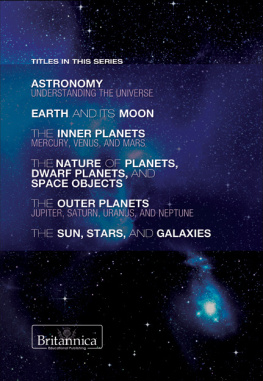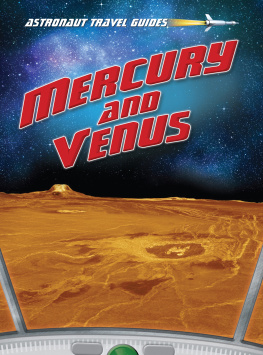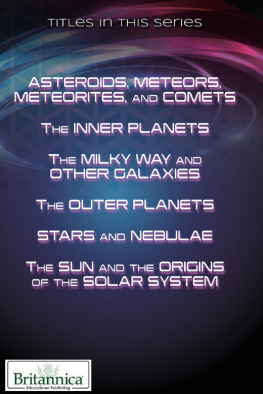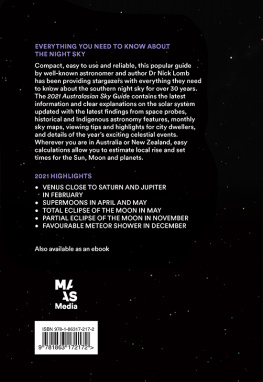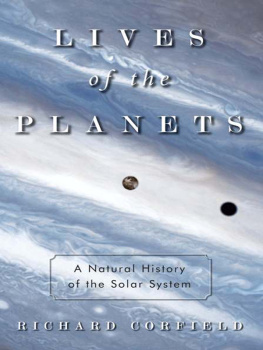THE
INNER PLANETS
MERCURY, VENUS, AND MARS
the solar system
THE
INNER PLANETS
MERCURY, VENUS, AND MARS
Edited by Sherman Hollar

Published in 2012 by Britannica Educational Publishing
(a trademark of Encyclopdia Britannica, Inc.)
in association with Rosen Educational Services, LLC
29 East 21st Street, New York, NY 10010.
Copyright 2012 Encyclopdia Britannica, Inc. Britannica, Encyclopdia Britannica, and the Thistle logo are registered trademarks of Encyclopdia Britannica, Inc. All rights reserved.
Rosen Educational Services materials copyright 2012 Rosen Educational Services, LLC.
All rights reserved.
Distributed exclusively by Rosen Educational Services.
For a listing of additional Britannica Educational Publishing titles, call toll free (800) 237-9932.
First Edition
Britannica Educational Publishing
Michael I. Levy: Executive Editor, Encyclopdia Britannica
J.E. Luebering: Director, Core Reference Group, Encyclopdia Britannica
Adam Augustyn: Assistant Manager, Encyclopdia Britannica
Anthony L. Green: Editor, Comptons by Britannica
Michael Anderson: Senior Editor, Comptons by Britannica
Sherman Hollar: Associate Editor, Comptons by Britannica
Marilyn L. Barton: Senior Coordinator, Production Control
Steven Bosco: Director, Editorial Technologies
Lisa S. Braucher: Senior Producer and Data Editor
Yvette Charboneau: Senior Copy Editor
Kathy Nakamura: Manager, Media Acquisition
Rosen Educational Services
Alexandra Hanson-Harding: Editor
Nelson S: Art Director
Cindy Reiman: Photography Manager
Matthew Cauli: Designer, Cover Design
Introduction by Alexandra Hanson-Harding
Library of Congress Cataloging-in-Publication Data
The inner planets : Mercury, Venus, and Mars / edited by Sherman Hollar.
p. cm.(The solar system)
In association with Britannica Educational Publishing, Rosen Educational Services.
Includes bibliographical references and index.
ISBN 978-1-61530-561-2 (eBook)
1. Inner planetsJuvenile literature. 2. Mercury (Planet) Juvenile literature. 3. Venus (Planet)
Juvenile literature. 4. Mars (Planet)Juvenile literature. I. Hollar, Sherman.
QB602.I56 2012
523.4dc22
2010053891
On the front cover, page : Illustration of Mars created by computer. Shutterstock.com
Cover (top), back cover, pp. www.istockphoto.com/Spectral-Design; remaining interior background image www.istockphoto.com/Sergii Tsololo
CONTENTS






introduction

S ince ancient times, humans have gazed in wonder at the vast blanket of stars covering the night sky. Records going back 5,000 years show that ancient Sumerian astronomers recognized that some stars moved differently than other celestial bodies. Three special objects they tracked are the three closest planets to Earth: Mercury, Venus, and Mars. These objects still fascinate today. This book will take you on a journey to learn about our neighbors in the solar system.
The first stop on our tour will be tiny Mercury. At less than two-fifths Earths size, it is the smallest of the eight planets. Because it is the closest planet to the Sun, it can complete an orbit around the Sun in only 88 Earth days. But it takes almost 59 Earth days to complete one rotation about its axis. Mercury has almost no atmosphere, leaving its dry and rocky surface little protection from crater blasts by asteroids. Mercury is the densest planet in the solar system.
Our second stop is Venus, the solar systems third smallest planet and the one most similar in size to Earth. Venuss atmosphere is remarkably massive. Made mostly of thick, heat-trapping layers of carbon dioxide, the heavy atmosphere makes it the hottest planet in the solar system. This thick atmosphere has also made it difficult to study the planets surface. Venuss orbit and rotation are also unusual. A year on Venus is 225 days. But the planet spins about its axis very slowly, completing one rotation about every 243 Earth daysmaking Venus the only planet in the solar system that takes longer to rotate once about its axis than to travel once around the Sun. Venus and Uranus are also the only two planets that rotate counterclockwise.
The third stop on our journey, Mars, the second smallest planet in the solar system, is only about half Earths size. The planet completes one revolution around the Sun in about 687 Earth days. A Martian day lasts a little longer than 24 hours. It also has two small potato-shaped moons. Observers have long wondered if there was life on Mars because it appears as if there are channels that might once have contained water, a necessary ingredient for life. In fact, there still is water on Mars, but most of it is frozen beneath the planets surface. The thin atmosphere doesnt shield the surface from harsh ultraviolet radiation or from being hit by space junk.
Since the beginning of the space age, humans have had the power to do more than study the inner planets from afar. The development of space probes and satellites has allowed us to send spacecraft to fly by and even land on these planets. Such missions have resulted in a number of discoveries. For instance, we now know that Mercury shrank considerably as it cooled early in its history and that Venus, though sizzlingly hot and dry today, probably once had oceans. And though we have yet to find signs of life on Mars, much evidence has been collected suggesting that Mars was once more Earth-like, with warmer temperatures as well as flowing water. Even now, space missions continue. In 2011 NASAs Messenger probe is thoroughly exploring Mercury, for instance. As you read this book, you will get a sense of what humans have learned so far about our three neighboring planetsand what we still have to discover.

Telescopic observers have noted distinctive bright and dark features on Mars for hundreds of years. One of the sharpest images taken from the vicinity of Earth, photographed by the Hubble Space Telescope, captures the red planet on the last day of spring in the northern hemisphere. The large dark marking just below and to the east of center is Syrtis Major. Beneath it is the giant impact basin Hellas, covered with an oval of white clouds. NASA/JPL/David Crisp and the WFPC2 Science Team
Chapter 1
CHARACTERISTICS OF MERCURY

Next page
